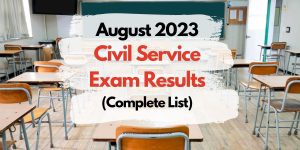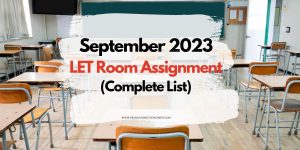This is the Multiples Choice Questions Part 6 of English. In preparation for the LET Exam, practice, and familiarize every question we have, it might be included in the actual examination. Good luck.
Be fully prepared for your exam, follow our tips on effective studying and test-taking strategies. Click here to read the tips:
| 3 Effective Prayers Before, During and After the Board Examination |
| Top 5 risky behaviors to avoid during board exam reviews. |
| Top 5 big mistakes when learning during board exam reviews. |
| More… |
English Part 6
1. Which is a correct description of motif in literary writing?
a. The main insight, central idea, or universal truth found in a literary work
b. An image or idea repeated throughout a work or several works of literature
c. The element of surprise in a work of fiction, such as twist ending
d. The writing style adopted by the author which is revealed in his/her word choice
Answer: a
2. Which of the following defines stylistics correctly?
a. It deals with expressive means which secures the desirable effect of the utterance.
b. It is the study of literacy discourse from a linguistic orientation.
c. It explicates the message to interpret and evaluate literary writings as works of art.
d. It is the study of language structure, sounds and meaning.
Answer: b
3. Which of the following best illustrates the figure of speech “understatement”?
a. “That’s wrong, Poe,” (Addressing somebody who does not know the answer)
b. “I think our comments differ slightly.” (“I do not agree with you at all.”)
c. “I’m so thirsty I could drink a pail of water.”
d. “That sound not intriguing.”
Answer: b
4. What stylistic device was employed in “And breaths were gathering sure / For that last onset, when the king/ Be witnessed in his power” (Emily Dickinson)?
a. Paradox
b. Irony
c. Antithesis
d. Oxymoron
Answer: d
5. In stylistics parlance, which term refers to the appropriateness of a work to intended subject, genre, and audience?
a. Diction
b. Tone
c. Point of View
d. Decorum
Answer: a
6. Which of the following excerpts is an example of the figure of speech “paradox”?
a. “The child is father of the man.” (Wordsworth)
b. “O hateful love, o loving hate! I burn and freeze like ice!” (Shakespeare)
c. “At the drunkard’s funeral, four of his friends carried the bier.”
d. “Don’t we all love peace and hate war?”
Answer: a
7. What figure of speech did Nathaniel Hawthorne use in making Rev. Dimmesdale metaphorically dim as the novel progresses while making Chillingworth have chilled heart?
a. Symbol
b. Charactonym
c. Allusion
d. Pun
Answer: d
8. Which of the following exemplifies the device “allusion”?
a. Shakespeare is a literary titan.
b. Death, be not proud.
c. Philippines, O, Pearl of the Orient
d. Not yet, Rizal, not yet
Answer: a
9. What techniques were used in the except “Sea nymphs hourly ring his knell/ Ding-dong. Hark!/ Now I hear them — Ding-dong bell”?
a. Consonance and rhythm
b. Onomatopeia and rhyme
c. Assonance and rhyme
d. Onomatopoeia and assonance
Answer: b
10. What device did Ovid use in the excerpt “And Icarus, his son, stood by and watch him/ Not knowing he was dealing with his downfall/ Stood by and watched, and raised his shiny face/ To boy will, always/ Whenever a father tries to get some work done”?
a. Flashback
b. Foreshadowing
c. Frame Story
d. Epiphany
Answer: b
11. What device did N. V. M. Gonzales use in the excerpt “After Longos River, the trail to Mauhaw clims the Hill of the White of the White Cows and for ten kilometers or so wanders about the rolling cogon country before finally entering the woods. Only then may one get glimpses of the sea, heart-warming pictures framed in by palma-brava and dao tress. Mauhaw Bay itself comes after woods, the winding trail, after the resin-fragrant winds that strum the buri leaves as through these were guitars.”
a. Simile
b. Local Color
c. Allusion
d. Personification
Answer: d
12.What device did Alexander Pope use in the excerpt “Here thou, great Anna, whom three realms obey/ Dost sometimes counsel take, and sometimes tea”?
a. Oxymoron
b. Paradox
c. Irony
d, Anticlimax
Answer: d
13. Which literary theory can give a meaningful criticism of the following poem?
“Hope” is the thing with feathers –
That perches in the soul –
Ans sings the tune without the words –
And never stops – at all-
And sweetest – in the Gale – is heard-
And sore must be the storm –
That could abash the little Bird
That kept so many warm
I’ve heard it in the chillest land –
And on the strangest Sea –
Yet – never – in Extremity,
It asked a crumb – of me.
a. New criticism
b. Realism
c. Naturalism
d. New historicism
Answer: a
14. Which of the following is the focus of medieval literary period?
a. Secular and individualistic
b. Aesthetic and social
c. Mundane and symbolic
d. Divine and spiritual
Answer: d
15. Which of the following does NOT characterize deconstructive reading of text?
a. Authorial intention fallacy renders meaning uncertain.
b. Language is a fixed system of sign.
c. A text is a combination of multiple shades of contradicting meaning.
d. It is a reading which analysis a text’s critical difference from its intended meaning.
Answer: b
16. Which is an example of the error deus ex machina?
a. The protagonist saw and talked to God.
b. The antagonist changed and turned to God.
c. The conflict is related to religion.
d. The plot ended with divine-intervention like way.
Answer: d
17. Which of the following is NOT true?
a. Romanticism emphasizes human subjectivity and imagination.
b. Post-modernism is highly structural, objective and empiricist.
c. Realism draws from the object and referential aspect of language and art.
d. The Renaissance movement brought about the other – worldly disposition in art and literature.
Answer: b
18. Which if the following is NOT true?
a. Marxism as a literary theory rejects the idea of “art for art’s sake.”
b. Formalism is criticism for meaning.
c. New Criticism promotes close reading and interpretation,
d. Psychoanalytic theory in literature attempts to interpret symbols in literature.
Answer: b
19. Which is known as the science of interpretation?
a. Hermeneutics
b. Textual exegesis
c. Literary Appreciation
d. Psychoanalytic theory in literature attempts to interpret symbols in literature.
Answer: a
20. Which of the following does NOT allow intertextual reading of literature?
a. Feminism Criticism
b. Marxism Criticism
c. New Criticism
d. Post-Colonial Criticism
Answer: c






